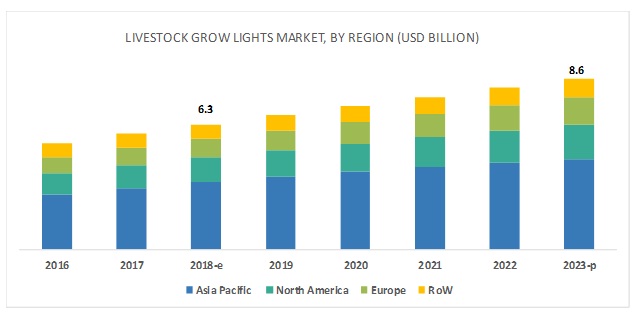The global livestock grow lights market size is projected to grow from USD 6.3 billion in 2018 to USD 8.6 billion by 2023, at a CAGR of 6.4% during the forecast period. Increasing consumption of animal-based products and rising focus on livestock productivity as well as livestock welfare are projected to drive the market for grow lights.
The major livestock grow lights vendors include OSRAM (Germany), Signify Holding (Netherlands), DeLaval (Sweden), Big Dutchman (Germany), Uni-light LED (Sweden), Once Inc. (US), AGRILIGHT BV (Netherlands), Aruna Lighting (Netherlands), HATO BV (Netherlands), Shenzhen Hontech-Wins (China), CBM Lighting (Canada), Fienhage Poultry Solutions (Germany), SUNBIRD (South Africa), ENIM UAB (Lithuania), and Greengage Lighting (UK).

Report Objectives:
- Determining and projecting the size of the livestock grow lights market with respect to type, livestock, installation type, and regional markets over a five-year period ranging from 2018 to 2023
- Identifying attractive opportunities in the market by determining the largest and fastest-growing segments across regions
- Providing detailed information about key factors influencing the growth of the market (drivers, restraints, opportunities, and industry-specific challenges)
- Analyzing the micromarkets with respect to individual growth trends, future prospects, and their contribution to the total market
- Identifying and profiling key market players in the livestock grow lights market
Download PDF Brochure:
https://www.marketsandmarkets.com/pdfdownloadNew.asp?id=77298993
The retrofit segment is estimated to dominate the market for livestock grow lights in 2018. Factors such as hot and humid environment and dust are projected to hinder the functioning of the lighting systems in farms. This makes it necessary for the farms to retrofit the existing lighting systems from time to time to ensure steady lighting supply to the livestock. Moreover, the low cost of LED retrofits has encouraged livestock growers to convert their traditional lighting systems into LED lighting systems for utilizing this technology.
The poultry segment is projected to witness the fastest growth during the forecast period. Factors such as the rising consumption of chicken and eggs and focus on sustainable growth are driving the livestock grow lights market for poultry. Turkey is the fastest growing sub-segment of poultry. The meat obtained from turkey is the leanest as compared to other birds, which is driving the market in countries such as Germany, France, and Italy.
Technological innovations and the adoption of smart livestock farming techniques that enhance productivity, efficiency, and profitability are driving the market for livestock grow lights. Farmers are focusing on enhancing traditional inputs such as air, water, housing, and nutrients in livestock farms. Now, they are shifting their focus on improving the lighting technology in barns to reduce energy usage and other input costs. Utilizing advanced lighting technology such as LED lighting is projected to create a positive impact on the unique spectral of lighting required for cattle, poultry, swine, and goats. Livestock growers can regulate the circadian rhythm, reduce stress, and increase the production of meat, eggs, and other protein sources by adopting smart livestock farming practices.
Make an Inquiry:
https://www.marketsandmarkets.com/Enquiry_Before_BuyingNew.asp?id=77298993
Key Questions addressed by the report:
- Who are the major market players in livestock grow lights market?
- What are the regional growth trends and the largest revenue-generating regions for livestock grow lights?
- Which are the major regions that are projected to witness a significant growth for livestock grow lights?
- What are the major types of livestock grow lights that are projected to gain maximum market revenue and share during the forecast period?
- Which is the major type of livestock where grow lights are used that will be accounting for majority of the revenue over the forecast period?